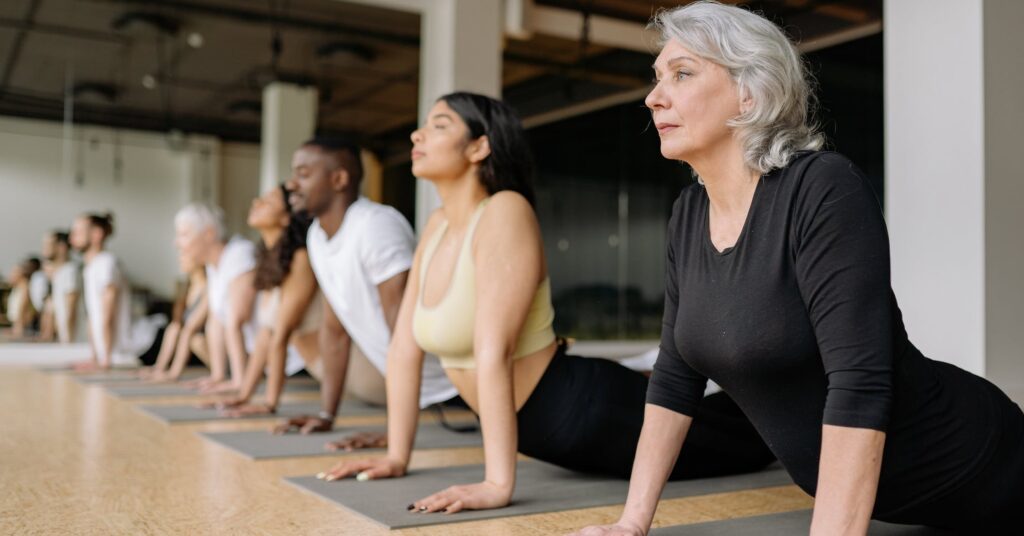
How is Occupational Therapy Used in Mental Health?
Occupational therapy originated as a mental health discipline. Today, mental [...]

Yoga—a form of meditation involving physical poses and breathing techniques that traces its roots back 5,000 years to northern India—may not at first seem a natural fit for a modern healthcare field like occupational therapy (OT). After all, what can contemporary medicine learn from such ancient practices?
However, on closer inspection, one learns that the early yoga practitioners were onto something. They knew how to calm the mind and relieve mental stress. They also discovered effective techniques to improve and maintain the body’s core strength, flexibility, movement, and balance.
Indeed, studies have demonstrated that yoga poses (asanas) and meditation—or a combination of the two—can help people with injuries, chronic pain, disabilities, Parkinson’s disease, and more improve and maintain their strength, flexibility, and functional mobility. It’s one of the many reasons that older adults practice yoga: it enhances their mind-body body awareness and supports their fine motor skills, balance, and gait.
Indeed, it turns out that yoga is a natural fit with occupational therapy. Both take a holistic approach to the individual. Both embrace the principle that combining physical and mental health treatments can have profound and far-reaching positive effects on a person’s overall well-being.
So, how is yoga used in occupational therapy? We explore this topic in this article while also discussing:
In many ways, yoga is ideally suited for use in occupational therapy, which employs a variety of exercises and activities to develop and maintain skills necessary to engage capably in activities of daily living (ADLs). Since yoga, like occupational therapy, is a person-centered practice that meets people where they are without judgment, occupational therapists can modify most yoga poses—as appropriate—for use in achieving their clients’ treatment goals.
In occupational therapy, yoga helps people maintain or regain core strength and range of motion, and supports the following:
Yoga also has been shown to improve cognitive functioning, particularly gross memory functioning and executive functions, in older adults.
All occupational therapy interventions include a mental health component to support clients’ functioning and independence. OTs treat mental illness in children, adolescents, the elderly, and others with severe and persistent mental illness.
Yoga’s focus on meditation—mindfulness, mantras, and breathing exercises—can help people cope with anxiety, stress, self-regulation, poor social skills, and depressive symptoms. Yoga therapy also has been shown to be beneficial in the treatment of autism spectrum disorders and ADHD.
Yoga instruction certification is not currently required by most states. However, certification organizations like the Yoga Alliance offer training programs with diplomas available after 200 and 500 hours of yoga practice.
Of course, occupational therapists are already skilled in many of the same techniques that are used in yoga, and their knowledge of anatomy and physiology, psychology, kinesiology, sensory integration, and biomechanics of the human body helps them identify which poses support their client’s OT needs.
Occupational therapists who want to incorporate yoga into their OT practice might want to look at yoga certification programs approved by American Occupational Therapy Association (AOTA).
The Accreditation Council for Occupational Therapy Education (ACOTE) requires a practicing occupational therapist to hold a master’s degree. Other OT roles—such as occupational therapy assistants and aides— don’t require graduate-level education, but you’ll need that master’s to obtain state licensure and gain entry-level OT employment.
All 50 states require OTs to hold a license to practice. All OTs must also pass the National Board for Certification in Occupational Therapy (NBCOT) exam. To qualify for the NBCOT, candidates must complete all fieldwork and obtain an occupational therapy degree from an accredited institution.
A master’s degree in occupational therapy takes two to three years to complete, depending on the school and program.
Several graduate programs lead to occupational therapy careers. You can earn a Master of Science in Occupational Therapy (MSOT) or Master of Occupational Therapy (MOT) (some opt for a Doctor in Occupational Therapy, including those who already have their OT master’s and others who want to pursue a career in academic research). You also need a baccalaureate degree to become an OT.
If your undergraduate degree isn’t in the health sciences (biology, kinesiology, psychology, or sociology), you’ll be required to take prerequisite courses in biology, human anatomy and human physiology, human development, developmental psychology, abnormal psychology, sociology, and statistics before starting your graduate-level OT coursework.
Most occupational therapy programs require applicants to have completed 40 to 50 hours of observation time under the supervision of a qualified occupational therapist before they apply to an OT program.
Although the admissions process for OT programs differs for each school, admissions criteria typically include:
Please note that the Occupational Therapist Centralized Application Service (OTCAS) allows prospective occupational therapy students to create one OTCAS application which they can submit to multiple programs.
Occupational therapy master’s degree programs focus on teaching the skills and training needed for OTs to practice and succeed. Students learn how to assess clients’ functional needs and develop and implement treatment plans to help them become more self-sufficient. Below are examples of occupational therapy master’s coursework at the University of Pittsburgh:
OT students must also complete two levels of fieldwork. The first level is a practicum in which students observe licensed OTs working in various settings and only participate in some parts of the therapy process (and then only under direct supervision). All programs at accredited institutions build a minimum of 24 weeks of full-time level II fieldwork, which is hands-on and more like an internship. Students provide occupational therapy services in various clinical settings under the supervision of a licensed occupational therapist.
Occupational therapists typically specialize after earning their master’s degree and working in the field. They accomplish this by earning a certificate from the American Occupational Therapy Association (AOTA) or other certificate-granting body. Common OT certificates include:
The American Occupational Therapy Association’s Accreditation Council for Occupational Therapy Education (ACOTE) has approved 220 master’s in occupational therapy programs in the United States. Students must have completed an ACOTE-accredited Occupational Therapy program to sit for the NBCOT exam.
According to US News & World Report, well-regarded occupational therapy programs in the US include:
Questions or feedback? Email editor@noodle.com

Occupational therapy originated as a mental health discipline. Today, mental [...]
Categorized as: Occupational & Behavioral Therapy, Nursing & Healthcare